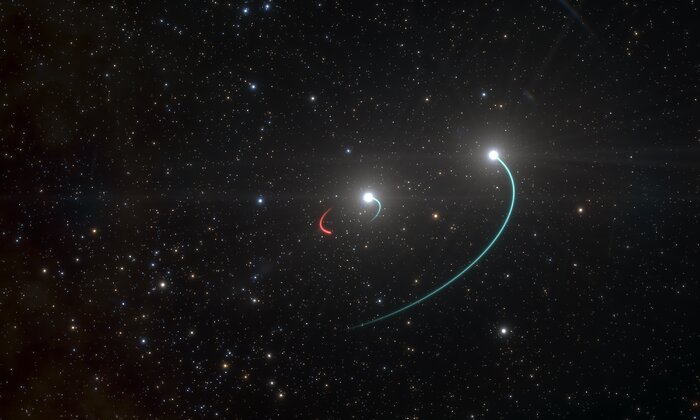Astronomers have discovered the closest black hole on record, located 1,100 light-years away from our solar system. This black hole is part of the star system HR 6819, which consists of two bright, bluish stars. On a clear, dark night, these stars can be seen with the naked eye in the constellation Telescopium from the Southern Hemisphere. See also: Black hole; Constellation; Light pollution; Light-year; Star

Researchers discovered the HR 6819 black hole serendipitously while conducting a broad study of binary (double star) systems with the MPG/ESO 2.2-metre telescope, located at the European Southern Observatory's La Silla Observatory in Chile. HR 6819 had long been classified as a typical binary system. These in-depth, recent observations revealed, however, that the inner star of the binary system is moving in a circle around a shared center of gravity with an invisible object, completing an orbit every 40 days. The orbital motion of the star indicates that the invisible object must have a mass at least four times that of the Sun. The only astrophysical object that can contain so much mass without producing light is a black hole. See also: Center of gravity; Mass; Orbital motion
Black holes range in mass from a few times tomany billions of times the mass of the Sun, and all share the same, namesake characteristic: intense gravity that prevents light from escaping into space. Yet as with HR 6819, black holes can still be indirectly detected because of their significant effects on their local cosmic environment. For most of the couple dozen or so small, stellar-mass black holes (similar to HR 6819's) that are currently known to exist in the Milky Way Galaxy, these objects have revealed their presences by actively consuming matter. That matter is typically siphoned off of companion stars and accelerated to extreme speeds and temperatures as the material swirls around the black hole. This process emits a telltale signature of high-energy x-rays, as well as other kinds of radiation. Likewise, the supermassive black holes found in most galaxies' cores are distinguishable through their associated matter's emissions. In the case of the Milky Way's central, supermassive black hole, its existence is further validated through observations of extreme velocities assumed by some stars as they orbit near the titanic object. These stars also display distinctive phenomena predicted by the theory of general relativity. Finally, in one case so far, a galaxy's supermassive black hole has been directly imaged, capturing the shadow it casts amid a disk of encircling material. See also: Event Horizon Telescope captures first image of a black hole; High-energy astrophysics; Matter; Milky Way Galaxy; Radiation; Relativity; Star's orbit of a supermassive black hole supports theory of relativity; Star's rosette-shaped orbit around a supermassive black hole supports general relativity; X-ray
Now that astronomers know how to detect invisible black holes within multiple-star systems, they expect to find many more like the one in HR 6819. Some of these black holes could be even closer to our solar system and suitable for new telescopic studies. See also: Telescope





